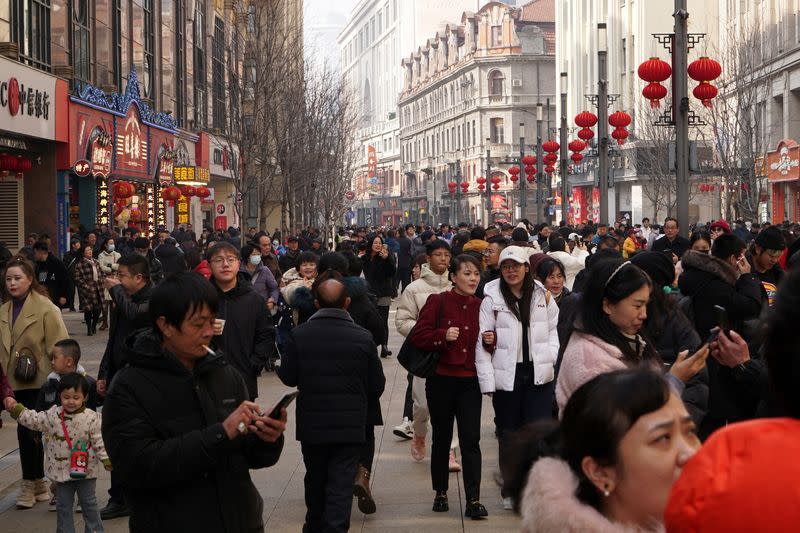Data released on Monday showed China’s factory output – up 7% – and retail sales were higher than expected in the first two months of this year.
Figures for the January-February period, which also saw a surprising uptick in exports, provide a solid start for 2024 and may be a relief to policymakers, despite the property sector crisis, which is likely to be a drag on the economy and confidence for some time.
Combined with soft consumer inflation, the data is an early boost for Beijing’s hopes of reaching what analysts have described as an ambitious 5.0% GDP growth target for this year.
ALSO SEE: As Korea Mulls Joining US Chip War, China Says ‘Don’t Give In’
“China’s activity data broadly stabilised at the start of the year. But there are still reasons to think some of the strength could be one-off,” Louise Loo, China economist at Oxford Economics, said.
Industrial output rose 7.0% in the first two months of the year, data released by the National Bureau of Statistics (NBS) showed on Monday, above expectations for a 5.0% increase in a Reuters poll of analysts and faster than the 6.8% growth seen in December. It also marked the quickest growth in almost two years.
Retail sales, a gauge of consumption, rose 5.5%, slowing from a 7.4% increase in December but beating an expected 5.2% gain.
Lunar New Year break lifted spending
The eight-day Lunar New Year holiday in February saw a solid return of travel, which supported revenue of tourism and hospitality sectors. That also led to a 3% growth in oil refinery throughput to meet strong demand for transport fuels.
The NBS publishes combined January and February industrial output and retail sales data to smooth out distortions caused by the shifting timing of the Lunar New Year.
“Consumers were buoyed temporarily by festivities-related spending at this start of the year. In the absence of decisive consumption-related stimulus this year, we think it would be difficult to sustain a robust consumer spending pace this year,” Oxford’s Loo said.
Loo’s cautious comments reflect broader consensus among China watchers that Beijing has its work cut out in achieving its 2024 economic growth target of “around 5%”. While the goal was similar to 2023, analysts note last year had a lower base effect due to Covid curbs in 2022.
Investors were relieved by the better-than-expected data, with Asian shares firming and Chinese blue chips up 0.4%.
Property sector demand still weak
A protracted crisis in the property sector, a key pillar of the economy, remains a major concern for policymakers, consumers and investors.
Monday’s data offered little relief on that front with declines in property investment narrowing in January-February, but still far from levels of reaching stability.
The frailty of the sector was highlighted by the poor demand. Property sales by floor area logged a 20.5% slide in January-February from a year earlier, compared with a 23% fall in December last year.
Goldman Sachs economists said China’s sequential growth momentum remained solid in the first quarter despite notable divergence across sectors.
“However, to secure the ambitious ‘around 5%’ growth target this year, more policy easing is still necessary, especially on the demand-side (eg, fiscal, housing and consumption).”
On the brighter side, fixed asset investment expanded 4.2% in the first two months of 2024 year-on-year, versus expectations for a 3.2% rise. It grew 3.0% in the whole of 2023.
Notably, private investment grew 0.4% in the first two months, reversing the decline of 0.4% in the whole year of 2023.
5.3% jobless rate in February
The job market, another area closely watched by authorities and investors, showed mixed results having deteriorated sharply during the Covid years.
The nationwide survey-based jobless rate rose to 5.3% in February from 5.2% January, which NBS spokesperson Liu Aihua attributed to seasonal factors associated with the Lunar New Year.
Premier Li Qiang promised at the annual parliamentary meeting earlier this month to transform the country’s growth model and defuse risks in the property sector and local government debt.
The country’s central bank governor Pan Gongsheng also said earlier this month that there was still room to cut banks’ reserve ratio requirement (RRR), following a 50-basis points cut announced in January, which was the biggest in two years.
Global monetary easing expectations may also offer some relief for China’s hopes of strengthening its vast manufacturing sector although economic conditions in many key developed nations look gloomy over the near-term. Britain slipped into a recession in the second half of last year, while Japan and the euro zone have shown meagre growth.
Policymakers have pledged to roll out further measures to help stabilise growth after the steps implemented since June had only a modest effect, but analysts caution Beijing’s fiscal capacity is now very limited and note Li’s address to the annual parliamentary meeting failed to inspire investor confidence.
Many economists say there is a risk that China may begin flirting with Japan-style stagnation later this decade unless authorities take steps to reorient the economy towards household consumption and market-allocation of resources.
“We expect economic momentum to improve further in the near term given the tailwind from policy stimulus,” Zichun Huang, China economist at Capital Economics, said.
“But this recovery may prove short-lived due to the economy’s underlying structural challenges”.
- Reuters with additional editing by Jim Pollard
ALSO SEE:
China Sees Better Than Expected 2024 Trade Growth
China’s Big Guns Defend GDP Target, Explain Economic Policies
Doubt on China’s Plan to Lift Consumption, Maintain Growth
PM Pledges to Revitalize China’s Economy, Aims at 5% Growth
China Asks Banks to Roll Over $13tn Local Debt at Lower Rates
Multiple Moves Needed to Defuse China’s Local Debt Crises
Chinese Graduates Quit Cities as Youth Unemployment Soars
Over 100 Chinese Cities Battling to Repay Their Debts: Rhodium
























